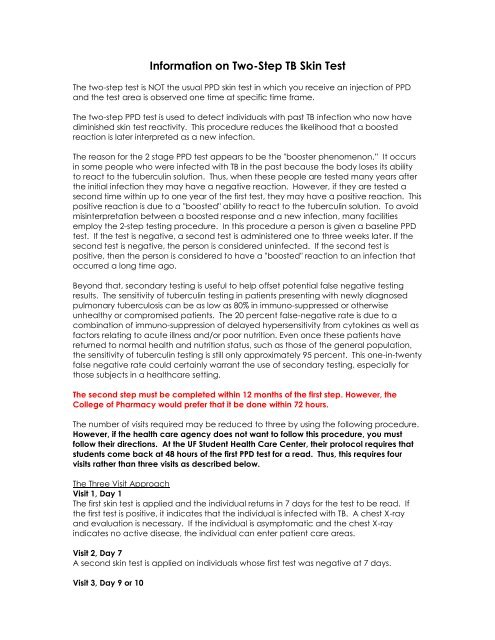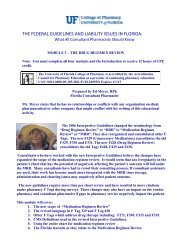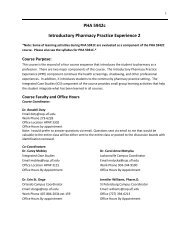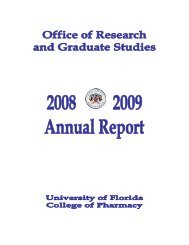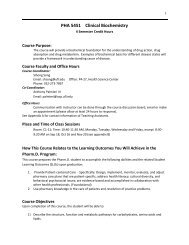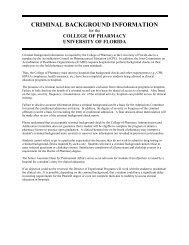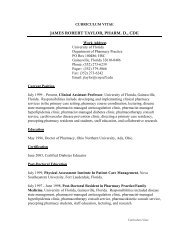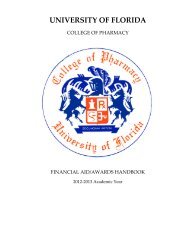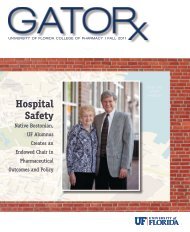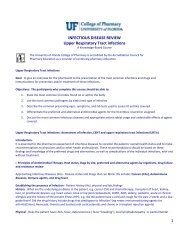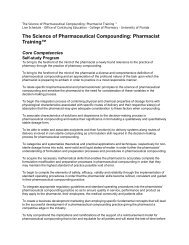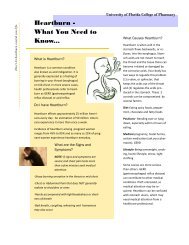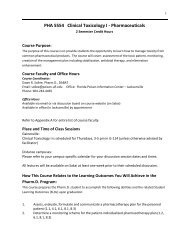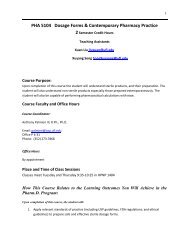Information on Two-Step TB Skin Test - College of Pharmacy
Information on Two-Step TB Skin Test - College of Pharmacy
Information on Two-Step TB Skin Test - College of Pharmacy
Create successful ePaper yourself
Turn your PDF publications into a flip-book with our unique Google optimized e-Paper software.
<str<strong>on</strong>g>Informati<strong>on</strong></str<strong>on</strong>g> <strong>on</strong> <strong>Two</strong>-<strong>Step</strong> <strong>TB</strong> <strong>Skin</strong> <strong>Test</strong><br />
The two-step test is NOT the usual PPD skin test in which you receive an injecti<strong>on</strong> <strong>of</strong> PPD<br />
and the test area is observed <strong>on</strong>e time at specific time frame.<br />
The two-step PPD test is used to detect individuals with past <strong>TB</strong> infecti<strong>on</strong> who now have<br />
diminished skin test reactivity. This procedure reduces the likelihood that a boosted<br />
reacti<strong>on</strong> is later interpreted as a new infecti<strong>on</strong>.<br />
The reas<strong>on</strong> for the 2 stage PPD test appears to be the "booster phenomen<strong>on</strong>.” It occurs<br />
in some people who were infected with <strong>TB</strong> in the past because the body loses its ability<br />
to react to the tuberculin soluti<strong>on</strong>. Thus, when these people are tested many years after<br />
the initial infecti<strong>on</strong> they may have a negative reacti<strong>on</strong>. However, if they are tested a<br />
sec<strong>on</strong>d time within up to <strong>on</strong>e year <strong>of</strong> the first test, they may have a positive reacti<strong>on</strong>. This<br />
positive reacti<strong>on</strong> is due to a "boosted" ability to react to the tuberculin soluti<strong>on</strong>. To avoid<br />
misinterpretati<strong>on</strong> between a boosted resp<strong>on</strong>se and a new infecti<strong>on</strong>, many facilities<br />
employ the 2-step testing procedure. In this procedure a pers<strong>on</strong> is given a baseline PPD<br />
test. If the test is negative, a sec<strong>on</strong>d test is administered <strong>on</strong>e to three weeks later. If the<br />
sec<strong>on</strong>d test is negative, the pers<strong>on</strong> is c<strong>on</strong>sidered uninfected. If the sec<strong>on</strong>d test is<br />
positive, then the pers<strong>on</strong> is c<strong>on</strong>sidered to have a "boosted" reacti<strong>on</strong> to an infecti<strong>on</strong> that<br />
occurred a l<strong>on</strong>g time ago.<br />
Bey<strong>on</strong>d that, sec<strong>on</strong>dary testing is useful to help <strong>of</strong>fset potential false negative testing<br />
results. The sensitivity <strong>of</strong> tuberculin testing in patients presenting with newly diagnosed<br />
pulm<strong>on</strong>ary tuberculosis can be as low as 80% in immuno-suppressed or otherwise<br />
unhealthy or compromised patients. The 20 percent false-negative rate is due to a<br />
combinati<strong>on</strong> <strong>of</strong> immuno-suppressi<strong>on</strong> <strong>of</strong> delayed hypersensitivity from cytokines as well as<br />
factors relating to acute illness and/or poor nutriti<strong>on</strong>. Even <strong>on</strong>ce these patients have<br />
returned to normal health and nutriti<strong>on</strong> status, such as those <strong>of</strong> the general populati<strong>on</strong>,<br />
the sensitivity <strong>of</strong> tuberculin testing is still <strong>on</strong>ly approximately 95 percent. This <strong>on</strong>e-in-twenty<br />
false negative rate could certainly warrant the use <strong>of</strong> sec<strong>on</strong>dary testing, especially for<br />
those subjects in a healthcare setting.<br />
The sec<strong>on</strong>d step must be completed within 12 m<strong>on</strong>ths <strong>of</strong> the first step. However, the<br />
<strong>College</strong> <strong>of</strong> <strong>Pharmacy</strong> would prefer that it be d<strong>on</strong>e within 72 hours.<br />
The number <strong>of</strong> visits required may be reduced to three by using the following procedure.<br />
However, if the health care agency does not want to follow this procedure, you must<br />
follow their directi<strong>on</strong>s. At the UF Student Health Care Center, their protocol requires that<br />
students come back at 48 hours <strong>of</strong> the first PPD test for a read. Thus, this requires four<br />
visits rather than three visits as described below.<br />
The Three Visit Approach<br />
Visit 1, Day 1<br />
The first skin test is applied and the individual returns in 7 days for the test to be read. If<br />
the first test is positive, it indicates that the individual is infected with <strong>TB</strong>. A chest X-ray<br />
and evaluati<strong>on</strong> is necessary. If the individual is asymptomatic and the chest X-ray<br />
indicates no active disease, the individual can enter patient care areas.<br />
Visit 2, Day 7<br />
A sec<strong>on</strong>d skin test is applied <strong>on</strong> individuals whose first test was negative at 7 days.<br />
Visit 3, Day 9 or 10
The sec<strong>on</strong>d test is read. A positive test 2nd test indicates <strong>TB</strong> infecti<strong>on</strong> in the distant past.<br />
The individual is referred for a chest X-ray and evaluati<strong>on</strong> by a physician. An<br />
asymptomatic individual, whose chest X-ray indicates no active disease may enter<br />
patient care areas.<br />
The majority <strong>of</strong> significant PPD skin test reacti<strong>on</strong>s will remain "positive" for 7 days after<br />
applicati<strong>on</strong>. Those that have diminished or disappeared by day 7 will be boosted back<br />
to positive by the 2nd skin test. Reducing the number <strong>of</strong> visits from 4 to 3 will not reduce<br />
the sensitivity <strong>of</strong> the two-step test.<br />
The Four Visit Approach<br />
Visit 1, Day 1<br />
The PPD antigen is applied under the skin.<br />
Visit 2, Day 3<br />
The PPD test is read. If the first test is positive, it indicates that the individual is infected<br />
with <strong>TB</strong>. A chest X-ray and evaluati<strong>on</strong> is necessary. If the individual is asymptomatic and<br />
the chest X-ray indicates no active disease, the individual can enter patient care areas.<br />
Visit 3, Day 7<br />
A sec<strong>on</strong>d PPD skin test is applied to those individual in whom the PPD skin test is negative.<br />
Visit 4, Day 9<br />
The sec<strong>on</strong>d test is read. A positive test 2nd test indicates <strong>TB</strong> infecti<strong>on</strong> in the distant past.<br />
The individual is referred for a chest X-ray and evaluati<strong>on</strong> by a physician. An<br />
asymptomatic individual whose chest X-ray indicates no active disease may enter<br />
patient care areas.<br />
For those individuals who were vaccinated against <strong>TB</strong> with BCG vaccine, you still can be<br />
tested with PPD after a 3-5 year period post the BCG vaccinati<strong>on</strong>. Positive PPD tests at<br />
this point could indicate <strong>TB</strong> infecti<strong>on</strong>. Thus, a chest x-ray is necessary.<br />
When a two-step PPD is indicated during the curriculum<br />
(http://www.cop.ufl.edu/studaff/prac1.pdf) and a student has shown prior evidence <strong>of</strong><br />
either positive PPD or BCG vaccinati<strong>on</strong>*, an updated health statement by a physician<br />
should be provided. It is the physician’s determinati<strong>on</strong> whether or not an additi<strong>on</strong>al<br />
chest x-ray is warranted. Please provide a physician’s interpretati<strong>on</strong> <strong>of</strong> a recent chest xray<br />
(within a m<strong>on</strong>th <strong>of</strong> a deadline for this informati<strong>on</strong>) and/or a physician’s statement<br />
that there is no clinical evidence <strong>of</strong> active <strong>TB</strong> infecti<strong>on</strong> and that you are permitted to<br />
enter patient care envir<strong>on</strong>ments. The physician’s statements about the chest x-ray<br />
interpretati<strong>on</strong> and/or clinical assessment <strong>of</strong> your status with regard to active <strong>TB</strong> should be<br />
<strong>on</strong> the physician’s letterhead with the student’s full name and UFID.<br />
*BCG vaccinati<strong>on</strong> can result in positive PPD tests for a period <strong>of</strong> approximately 3-5 years.<br />
After this time, PPD skin tests can be administered. A positive PPD after this time frame<br />
could still indicate possible reacti<strong>on</strong> to the antigens in BCG vaccine or exposure to the<br />
tuberculosis organism. A follow-up chest x-ray and clinical assessment as determined by<br />
a physician may be necessary for a positive PPD under this circumstance.<br />
H/Group/Student Affairs/Background Checks and Data Collecti<strong>on</strong>/<strong>TB</strong>/<str<strong>on</strong>g>Informati<strong>on</strong></str<strong>on</strong>g> <strong>on</strong> <strong>Two</strong> <strong>Step</strong> PPD.doc<br />
Rev 052312/src


